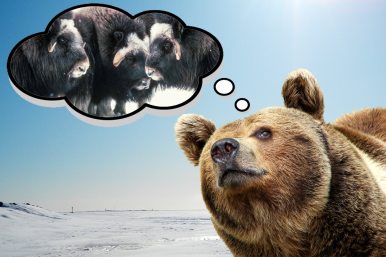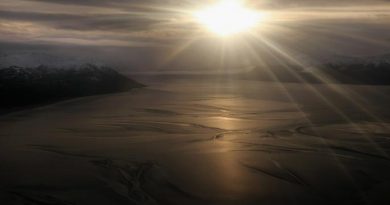Taking down killer bears so musk ox can thrive on Alaska’s North Slope
 More than a few baby musk ox on the North Slope owe their lives to Alaska Department of Fish and Game employees, who decided there really are times when you can’t let nature run wild, as a former state governor once so famously observed.
More than a few baby musk ox on the North Slope owe their lives to Alaska Department of Fish and Game employees, who decided there really are times when you can’t let nature run wild, as a former state governor once so famously observed.
With marauding grizzly bears taking a toll on the young of the shaggy — but not so smart — survivors from the Ice Age, biologists with the state agency decided that maybe it was time for an intervention. So they executed three known musk ox killers this spring, with the approval of the Alaska Board of Game.
“We killed three male bears,” said Beth Lenart, area wildlife biologist. All appear to have been recidivists. Doug Vincent-Lang, director of the state Division of Wildlife Conservation, called the grizzly shootings “targeted removals” of known musk-ox killers.
Viral musk ox video
Two of the dead grizzlies were feeding on musk-ox calves when killed. The third grizzly was sitting near a herd, sizing it up for attack. Researchers studying the grizzlies that wander through the oil fields of Arctic Alaska discovered that some bears had become adept at killing musk ox. A video of one such attack, which left two calves dead, went viral.
In the video, a grizzly can be seen watching a circle of musk ox forming a protective ring around calves on an oil field road. But when the bear rushes them, the protective ring breaks, and the animals flee. Three calves struggle to keep up. The bear grabs one of them in its jaws at full speed and keeps running at nearly full speed. A second calf stops fleeing and turns, almost as if to make friends with the bear. It is a fatal mistake. The bear drops the calf it is carrying and kills the second calf as well.
Mammalian contemporaries of the woolly mammoth, saber-toothed cat, giant ground sloth, short-faced bear and other now-extinct Pleistocene critters, musk ox have struggled to survive in modern times due to a shrinking range and a vulnerability to predators — both wild and human.
Extirpated from Alaska by hunters in the mid-1800s — some accounts put the death of the last herd near Wainwright on the western North Slope in 1864 or 1865 — the animals which had once colonized a large part of the northern globe were threatened with extinction. They were gone from Asia and Europe, where they once ranged as far south as France. None were left in the Lower 48 states, either. Only in the then-territory of Alaska, Greenland and the remote Canadian north did musk ox hang on.
Incredibly long journey
Fears that the species might disappear led to the 1930 capture of a herd of 34 in east Greenland for transplant to Alaska. The U.S. Congress, which paid for the capture, hoped the animals could be domesticated and used to start an agricultural industry in the territory. It was with similar thoughts that the U.S. government, only years later, offered 203 families from Minnesota, Wisconsin and Michigan a free trip to Alaska and some help in establishing what become known as the Matanuska Colony. By the time the colonists arrived in 1935, the musk ox were nearing the end of an incredibly long journey on the way to their own colony.
According to a National Park Service history, the animals were first captured by Norwegian sailors and shipped back to Norway. There they were loaded on a steamship for a voyage across the Atlantic Ocean to New York. A month-long quarantine followed before the animals were hauled cross-country by train to Seattle. Another steamship awaited.
It hauled them about 1,400 miles up the Pacific Ocean coast to Seward, the terminus of the Alaska Railroad. There they were put on yet another train to be hauled to Fairbanks. For five years, the musk ox lived in a clearing in the forest near the old Interior mining community. Then in 1935, as the human colonists were arrived in the Matanuska Valley, the musk ox began their last journey to a new home. Loaded onto the Interior river boats of the time, they started a journey down the Yukon River to the Bering Sea.
Off-loaded at the mouth of the Yukon, according to the park service, the animals were put on a barge that nearly sank in a Bering Sea storm. Men with hand pumps had to battle to keep it afloat until they arrived at Nunivak Island, a barren patch of tundra 30 miles off the Alaska coast. There the musk ox were released to start their own colonization program in 1936. They were at the time the only musk ox in Alaska, and they would remain the only musk ox in Alaska for the next three decades.
Expanding in Alaska
It wasn’t until 1967 that the new state of Alaska began efforts to expand the species’ range. That year, the state began taking musk ox from a Nunivak herd that had grown to more than 400 animals. Twenty-three of them were moved to Nelson Island, about 20 miles across Etolin Strait from Nunivak. The musk ox flourished in their new home, as they had on Nunivak Island. More transplants followed at the start of the 1970s on the Seward Peninsula near Nome, in the western Brooks Range near Kotzebue, and along the Arctic Coast.
In most places, the musk ox thrived, but in some areas problems popped up. The 64 musk ox reintroduced to the eastern North Slope increased to 300 animals by the 1980s and began expanding their range west toward the oil fields and east across the Arctic National Wildlife Refuge into the Yukon Territory, Canada. By 1996, there were up to 700 of the animals scattered along the coast from Prudhoe Bay east through ANWR into the Yukon. Then something happened.
Federal biologists reported the animals gone from ANWR by 2006. Aerial searches found 216 musk ox west of the refuge and 79 living in Canada. Reports of a few more remote bands roaming the Brooks Range led to a population estimate of 400 — two thirds or less of the peak count. Studies began to determine the causes for the decline. The usual culprits were identified:
•Weather, in this case animals starved by icing events, drowned in floods or carried out to sea on ice flows;
•Disease and parasites;
•Hunting, including the poaching of a few animals;
•Food shortages; and
•Predation
Killer bears
A state Oilfield Grizzly Project underway at the same time documented 16 different marked bears — and a few unmarked bears — making 47 musk ox kills over the span of 14 years. Some of the bears appeared to be getting pretty good at it. Many got lucky and killed a musk ox as a target of opportunity, but others appeared to have learned how to hunt ox and were making a habit of it. This, many realized, presented a situation in which humans might be able to help the prehistoric creatures.
So in January, the Alaska Game Board approved the aerial shooting of musk-ox-eating bears in Arctic Ocean drainages west of the Canning River with the idea of helping rebuilding the musk ox population in the area to 300 animals. So-called “predator control” by aerial hunting is usually a controversial issue in Alaska. This shoot wasn’t.
“It’s actually been remarkable that there hasn’t been much controversy on this one,” said Cathie Harms, a state wildlife biologist in Fairbanks.
Lenart, meanwhile, is quick to stress that this aerial hunt was not a “predator control” program in the normal sense of the phrase. Past programs have been aimed a reducing the overall number of wolves or bears to increase the chances prey will survive. The goal here was not to reduce the overall number of bears, Lenart said. In fact, the bears killed to save musk ox were counted as part of the quota of 21 bears that can be killed in the game-management unit.
The only goal here, she said, was to remove the musk ox killers, which have been taking down not only calves but productive females vital to the long-term survival of the herd.
“We documented three (female) adults killed last year,” she said, and nine in the past several years. “We wanted to stop that, too.”
Calf survival improves
Predation is a problem, she said, because of the unique nature of the North Slope. Male grizzlies usually emerge from their dens there in April. Not much is available to eat at that time of year. Most of the animals in the Porcupine caribou herd are still on their winter range south of the Brooks Range, which remains covered in snow. There are no greens. So the emerging bears go looking for what they can find: winter-kill carcasses of moose or caribou, remains of dead whales or marine mammals, or the only other living things around — musk ox.
But this year it proved dangerous for bears hunt musk ox. Of five bears believed to have been doing so, Fish and Game killed three. That was good news for the musk ox. Calf survival went from less than 65 percent of the calves to about 80 percent. Whether the project worked, however, remains to be seen. It’s possible the bears were merely engaged in what biologists call “compensatory predation,” meaning the bears were only killing musk ox destined to die over winter anyway due to food shortages or disease.
Lenart will have to wait until next spring to find the answer to whether the bear kills truly upped survival and helped increase the size of the musk ox herd. She is hopeful. “Usually, we don’t lose that many over winter,” she said, but then usually the herds don’t go into winter with so many calves.
“It’s not conclusive, but it looks good,” Harms added.
It must look really good if you’re a baby musk ox. Having a shot at survival has to beat being torn apart by a grizzly bear.
Contact Craig Medred at craig(at)alaskadispatch.com
For more stories from Alaska Dispatch, click here




That’s just wrong. Nature takes care of it’s own. Were messing with the world in so many wrong ways, in the end were all going to pay for it.
Stop killing are wild life. We’ve taken away their land, now your killing them off because there eating what doesn’t belong in Alaska anyways.
What’s this world coming too.